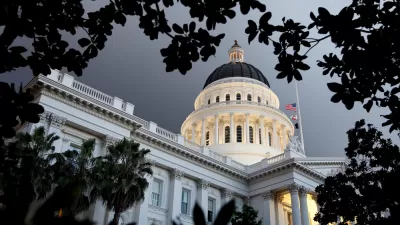Gov. Jerry Brown, accompanied by former Gov. Arnold Schwarzenegger, signed legislation to continue the cap-and-trade program initially authorized under a bill signed by his Republican predecessor 11 years ago at the same Treasure Island location.
Tuesday's ceremony on the man-made island in San Francisco Bay, overlooking San Francisco's skyline, was held to mark the signing of hard-fought legislation to continue application of one of the state's most important tools to combat climate change. Eleven years earlier on September 27, 2006, Gov. Arnold Schwarzenegger held a similar but even more important ceremony to mark the signing of "AB 32, the California Global Warming Solutions Act, making California the first state in the nation to cap greenhouse gas emissions and establishing California as a worldwide leader in addressing climate change," notes Schwarzenegger's website.
AB 398, which passed with a two-thirds supermajority by a one-vote margin in each chamber on July 17, takes up where AB 32 ends on December 31, 2020: it will enable the use of cap-and-trade to help reduce greenhouse gas emissions in the Golden State 40 percent below 1990 levels by 2030, meeting the goal of SB 32.
Only one Republican legislator voted for AB 32 in 2006. Eight Republicans broke party lines to cast votes in support AB 398 by Assemblymember Eduardo Garcia (D-Coachella) on July 17.
But it was the business representatives gathered on Treasure Island on July 25 that really illustrated the differences on California legislation to fight climate change between now and then.
"Brown openly embraced the business community in his address, noting the many business lobbyists and representatives in attendance," reports Guy Marzorati for KQED News.
“Some people say, ‘Oh my god, we don’t like those people,’ ” he said (see video). “Well let’s face it, this is California. Our industry, our wealth, our whole well-being is the product of all these individuals and companies and organizations and cultural organizations and nonprofits, the whole thing.”
After the first auction of carbon allowances held by of the cap-and-trade program in November 2012, the California Chamber of Commerce sued the state, claiming the carbon sales were illegal taxes. CalChamber and other business representatives were present to celebrate the signing of AB 398.
Cap-and-trade is coming up short
David R. Baker, clean tech and energy reporter for the San Francisco Chronicle, also covered Tuesday's celebration. However, he reports that cap-and-trade may not be living up to its reputation as the centerpiece of California's greenhouse gas reduction efforts.
There remains, however, uncertainty about how much cap and trade will contribute to the state’s overall fight against global warming. Other policies — including tougher mileage requirements for cars and a state requirement that utilities use more renewable power — appear to be having a greater impact.
And in 2015, the most recent year for which data are available, California’s greenhouse gas emissions fell less than 1 percent. [Also see Planetizen post on the California Air Resources Board 2015 Greenhouse Gas Inventory release: "California Progress Report: GDP Increases While GHGs Fall"].
Those last inventory numbers were a warning sign,” said Chris Busch, director of research at the Energy Innovation consulting firm. “I think cap and trade is running well. The question is how quickly will it get us on the trajectory we need for 2030?”
Three-bill package climate deal
On Wednesday (July 26) in Bell Gardens, Los Angeles County, "Gov. Brown signed AB 617 by Assemblymembers Cristina Garcia (D-Bell Gardens), Eduardo Garcia (D-Coachella) and Miguel Santiago (D-Los Angeles) to establish a groundbreaking program to measure and combat air pollution at the neighborhood level - in the communities most impacted," notes the governor's office on the bill that addresses environmental justice.
"There's an old expression, 'think globally, act locally.' The cap-and-trade and air quality bills the Governor is signing into law this week do both," stated Assembly Speaker Anthony Rendon (D-Lakewood, Los Angeles County).
FULL STORY: Brown, Schwarzenegger Celebrate Extension of Cap and Trade

Maui's Vacation Rental Debate Turns Ugly
Verbal attacks, misinformation campaigns and fistfights plague a high-stakes debate to convert thousands of vacation rentals into long-term housing.

Planetizen Federal Action Tracker
A weekly monitor of how Trump’s orders and actions are impacting planners and planning in America.

In Urban Planning, AI Prompting Could be the New Design Thinking
Creativity has long been key to great urban design. What if we see AI as our new creative partner?

Florida Seniors Face Rising Homelessness Risk
High housing costs are pushing more seniors, many of them on a fixed income, into homelessness.

Massachusetts Budget Helps Close MBTA Budget Gap
The budget signed by Gov. Maura Healey includes $470 million in MBTA funding for the next fiscal year.

Milwaukee Launches Vision Zero Plan
Seven years after the city signed its Complete Streets Policy, the city is doubling down on its efforts to eliminate traffic deaths.
Urban Design for Planners 1: Software Tools
This six-course series explores essential urban design concepts using open source software and equips planners with the tools they need to participate fully in the urban design process.
Planning for Universal Design
Learn the tools for implementing Universal Design in planning regulations.
Gallatin County Department of Planning & Community Development
Heyer Gruel & Associates PA
JM Goldson LLC
City of Camden Redevelopment Agency
City of Astoria
Transportation Research & Education Center (TREC) at Portland State University
Jefferson Parish Government
Camden Redevelopment Agency
City of Claremont



























